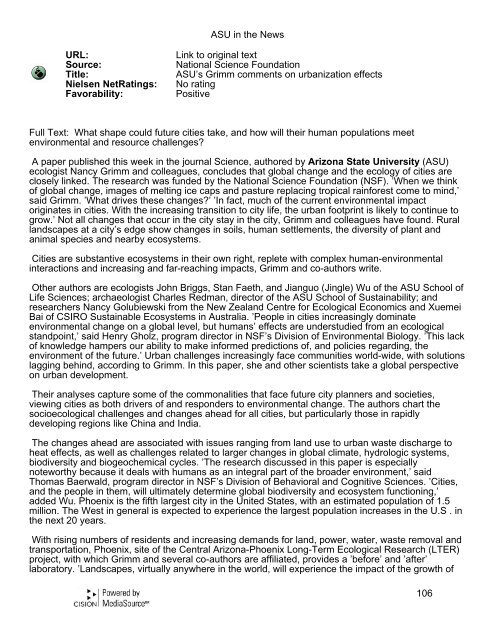asu in the news 02-06-08 to - ASU News - Arizona State University
asu in the news 02-06-08 to - ASU News - Arizona State University
asu in the news 02-06-08 to - ASU News - Arizona State University
- No tags were found...
You also want an ePaper? Increase the reach of your titles
YUMPU automatically turns print PDFs into web optimized ePapers that Google loves.
<strong>ASU</strong> <strong>in</strong> <strong>the</strong> <strong>News</strong><br />
URL: L<strong>in</strong>k <strong>to</strong> orig<strong>in</strong>al text<br />
Source: National Science Foundation<br />
Title: <strong>ASU</strong>’s Grimm comments on urbanization effects<br />
Nielsen NetRat<strong>in</strong>gs: No rat<strong>in</strong>g<br />
Favorability: Positive<br />
Full Text: What shape could future cities take, and how will <strong>the</strong>ir human populations meet<br />
environmental and resource challenges?<br />
A paper published this week <strong>in</strong> <strong>the</strong> journal Science, authored by <strong>Arizona</strong> <strong>State</strong> <strong>University</strong> (<strong>ASU</strong>)<br />
ecologist Nancy Grimm and colleagues, concludes that global change and <strong>the</strong> ecology of cities are<br />
closely l<strong>in</strong>ked. The research was funded by <strong>the</strong> National Science Foundation (NSF). ’When we th<strong>in</strong>k<br />
of global change, images of melt<strong>in</strong>g ice caps and pasture replac<strong>in</strong>g tropical ra<strong>in</strong>forest come <strong>to</strong> m<strong>in</strong>d,’<br />
said Grimm. ’What drives <strong>the</strong>se changes?’ ’In fact, much of <strong>the</strong> current environmental impact<br />
orig<strong>in</strong>ates <strong>in</strong> cities. With <strong>the</strong> <strong>in</strong>creas<strong>in</strong>g transition <strong>to</strong> city life, <strong>the</strong> urban footpr<strong>in</strong>t is likely <strong>to</strong> cont<strong>in</strong>ue <strong>to</strong><br />
grow.’ Not all changes that occur <strong>in</strong> <strong>the</strong> city stay <strong>in</strong> <strong>the</strong> city, Grimm and colleagues have found. Rural<br />
landscapes at a city’s edge show changes <strong>in</strong> soils, human settlements, <strong>the</strong> diversity of plant and<br />
animal species and nearby ecosystems.<br />
Cities are substantive ecosystems <strong>in</strong> <strong>the</strong>ir own right, replete with complex human-environmental<br />
<strong>in</strong>teractions and <strong>in</strong>creas<strong>in</strong>g and far-reach<strong>in</strong>g impacts, Grimm and co-authors write.<br />
O<strong>the</strong>r authors are ecologists John Briggs, Stan Faeth, and Jianguo (J<strong>in</strong>gle) Wu of <strong>the</strong> <strong>ASU</strong> School of<br />
Life Sciences; archaeologist Charles Redman, direc<strong>to</strong>r of <strong>the</strong> <strong>ASU</strong> School of Susta<strong>in</strong>ability; and<br />
researchers Nancy Golubiewski from <strong>the</strong> New Zealand Centre for Ecological Economics and Xuemei<br />
Bai of CSIRO Susta<strong>in</strong>able Ecosystems <strong>in</strong> Australia. ’People <strong>in</strong> cities <strong>in</strong>creas<strong>in</strong>gly dom<strong>in</strong>ate<br />
environmental change on a global level, but humans’ effects are understudied from an ecological<br />
standpo<strong>in</strong>t,’ said Henry Gholz, program direc<strong>to</strong>r <strong>in</strong> NSF’s Division of Environmental Biology. ’This lack<br />
of knowledge hampers our ability <strong>to</strong> make <strong>in</strong>formed predictions of, and policies regard<strong>in</strong>g, <strong>the</strong><br />
environment of <strong>the</strong> future.’ Urban challenges <strong>in</strong>creas<strong>in</strong>gly face communities world-wide, with solutions<br />
lagg<strong>in</strong>g beh<strong>in</strong>d, accord<strong>in</strong>g <strong>to</strong> Grimm. In this paper, she and o<strong>the</strong>r scientists take a global perspective<br />
on urban development.<br />
Their analyses capture some of <strong>the</strong> commonalities that face future city planners and societies,<br />
view<strong>in</strong>g cities as both drivers of and responders <strong>to</strong> environmental change. The authors chart <strong>the</strong><br />
socioecological challenges and changes ahead for all cities, but particularly those <strong>in</strong> rapidly<br />
develop<strong>in</strong>g regions like Ch<strong>in</strong>a and India.<br />
The changes ahead are associated with issues rang<strong>in</strong>g from land use <strong>to</strong> urban waste discharge <strong>to</strong><br />
heat effects, as well as challenges related <strong>to</strong> larger changes <strong>in</strong> global climate, hydrologic systems,<br />
biodiversity and biogeochemical cycles. ’The research discussed <strong>in</strong> this paper is especially<br />
noteworthy because it deals with humans as an <strong>in</strong>tegral part of <strong>the</strong> broader environment,’ said<br />
Thomas Baerwald, program direc<strong>to</strong>r <strong>in</strong> NSF’s Division of Behavioral and Cognitive Sciences. ’Cities,<br />
and <strong>the</strong> people <strong>in</strong> <strong>the</strong>m, will ultimately determ<strong>in</strong>e global biodiversity and ecosystem function<strong>in</strong>g,’<br />
added Wu. Phoenix is <strong>the</strong> fifth largest city <strong>in</strong> <strong>the</strong> United <strong>State</strong>s, with an estimated population of 1.5<br />
million. The West <strong>in</strong> general is expected <strong>to</strong> experience <strong>the</strong> largest population <strong>in</strong>creases <strong>in</strong> <strong>the</strong> U.S . <strong>in</strong><br />
<strong>the</strong> next 20 years.<br />
With ris<strong>in</strong>g numbers of residents and <strong>in</strong>creas<strong>in</strong>g demands for land, power, water, waste removal and<br />
transportation, Phoenix, site of <strong>the</strong> Central <strong>Arizona</strong>-Phoenix Long-Term Ecological Research (LTER)<br />
project, with which Grimm and several co-authors are affiliated, provides a ’before’ and ’after’<br />
labora<strong>to</strong>ry. ’Landscapes, virtually anywhere <strong>in</strong> <strong>the</strong> world, will experience <strong>the</strong> impact of <strong>the</strong> growth of<br />
1<strong>06</strong>


